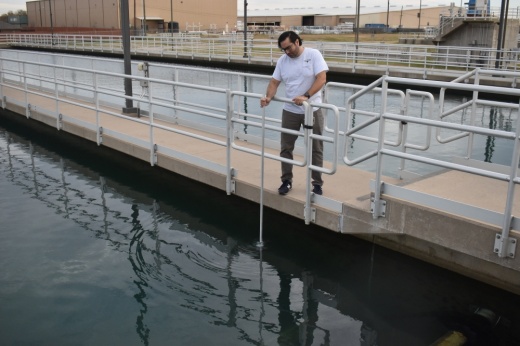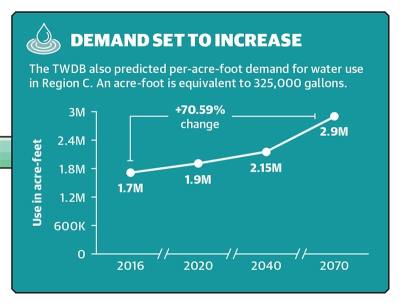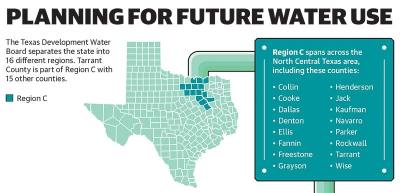The Tarrant Regional Water District, based in Fort Worth, is one of the main wholesale water distributors in North Texas, providing water to more than 70 towns across 11 counties, according to its website.
Towns, such as Keller, Roanoke, Fort Worth, Trophy Club and Westlake, receive water that has gone through the TRWD.
Water that reaches Tarrant County comes from the TRWD and a combination of its four reservoirs. Each of those—Lake Bridgeport, Eagle Mountain Lake, Cedar Creek Reservoir and Richland-Chambers Reservoir—plays a role in delivering water to residents in Tarrant County.
The TRWD stores extra water in either Benbrook Lake or Lake Arlington, owned by the U.S. Army Corps of Engineers and the city of Arlington, respecitvely, to keep up with the projected growth in the region.
The district has a wetlands area at the Richland-Chambers Reservoir to help preserve water, and there are plans to make another wetland area at Cedar Creek, according to Zach Huff, TRWD water resource engineering director.
The Cedar Creek Wetland is a multi-million-dollar project that will start construction in 2025, Huff added. A $11.2 million contract was awarded in December 2021 for the planning and design of the facility. The final cost is unknown, according to TRWD officials.
The 3,000-acre project is expected to produce 80 million gallons of water a day and supply enough water to serve an additional 560,000 people by 2032, according to a district press release.
“[The district] is continually studying water supply alternatives in its planning, and that data shows we are ready to begin the Cedar Creek Wetlands,” said Rachel Ickert, TRWD chief water resources officer.
One future project was purchasing raw water from Dallas Water Utilities in 2060 that was in the 2016 report but was removed in the 2020 report, according to TRWD.
Projected growth
The projected growth the TRWD is planning for comes from data supplied by the Texas Water Development Board, a state agency based in Austin.
The Texas Water Development Board was formed in 1957 at the end of a seven-year drought that was the worst in the state’s history. The development board predicts not only what water demands will be through 2070, but also the growth that could happen in different areas of the state.
The state’s 254 counties are divided into 16 regions by the board. Region C features Tarrant, Dallas, Denton and Collin counties, all of which have at least one city with a population of 100,000 or more, according to 2020 U.S. Census data.
The board’s 2021 water report stated Region C’s population is increasing by more than 300 people per day.
“The purpose behind [the water plans] is just making sure we identify the projected population growth and the projected water demands by sectors of use,” said Temple McKinnon, the Texas Water Development Board’s director of water supply planning. “The state water plans’ purpose is to identify where water supply needs will be if there is a recurrence of drought of record; that is the benchmark we plan to.”
The 2021 Region C water plan shows a 2.4% increase in the projected population in 2070 to 14.6 million people from the 2016 Region C plan. The difference equates to 330,000 more residents projected to be in the region. As of 2020, the Region C population was 7.6 million.
Texas Water Development Board officials noted Region C’s population more than tripled from 1960-2010 from fewer than 2 million to more than 6 million.
Tarrant County is the third-most populous county in the state, according to the 2020 U.S. Census, behind Harris County in the Houston area and Dallas County. The most recent census showed Tarrant County with a 16.7% increase in population from 2010, up to 2.11 million in 2020.
The Texas Water Development Board projects a 92% increase in Region C’s population from 2020 to 2070. The projections show Tarrant County will reach 2.2 million people in 2030 and 3.1 million people in 2070.
“That’s the wild card, because there are so many people that are migrating here from other states,” said J. Kevin Ward, Trinity River Authority general manager and Region C board chair. “Our demographics are changing pretty rapidly.”
Ward noted that sometimes cities have differing projections than the state demographer for future growth. Venus, a town southwest of Midlothian in Region C, expects a larger population burst than the state is predicting, he said.
The town is asking for more water and wastewater from the Mountain Peak Special Utility District, expecting a population of 35,000 by 2030, up from just over 5,000 as of 2020.
“We don’t like going beyond that state demographer, but they show us the applications from developers of subdivisions,” Ward said. “[If] the developers put down 5,000 [multifamily] units on the ground in the next three years, it’s easy to see how it could double or triple your population in a year.”
Ward, who has been involved in water-related jobs since 1987, said he has seen that kind of growth before in Tarrant County.
He pinpointed Keller, which has grown from a population of 13,668 in 1990 to more than 45,397 in 22 years—a 232% increase—according to numbers from the U.S. Census.
“Keller was a very small community and very rural, and hardly anyone lived out there,” Ward said. “Now, it is just wall to wall. The other cities that are up there, they are sandwiched around it and are in the same situation.”
With the projected rise in population in Region C, there is also a similar rise in water demand projections—a 67% increase to 2.9 million acre-feet per year. An acre-foot of water is measured as 1 foot tall, 66 feet wide and 660 feet long—the equivalent of 325,000 gallons of water.
In 2016, Region C accounted for 25% of all of Texas’ population but less than 10% of water used, according to the 2021 Texas Water Development Board report.
Tarrant County is expected to rise from using the seventh-most water per acre-foot in the state to fourth by 2070, according to the Texas Water Development Board projections.
"The water development board is there to ensure we aren’t over planning but we aren’t under planning,” Ward said. “If you under-plan, it shuts the economy down. With over-planning, you’d have some extra in case you need it, and you might need it.”
Water sources
The Texas Water Development Board’s plans for water usage throughout the state are used by the 30 different sellers of water in Region C.
The TRWD plays a part in delivering the water from its many reservoirs to households and businesses throughout Tarrant County. They are one of five major wholesale companies in Region C. The other companies are Dallas Water Utilities, the North Texas Municipal Utility District, the Upper Trinity Regional Water District and the Greater Texoma Utility Authority.
The TRWD delivers untreated water to more than 70 entities, but the four largest are Fort Worth, Mansfield, Arlington and the Trinity River Authority, according to TRWD Public Affairs Officer Chad Lorance.
Water customers
Once the TRWD delivers water to the wholesalers, those customers then treat the water and ship it off to the cities and towns in Tarrant County, according to Lorance.
Keller, Westlake, Roanoke and Trophy Club all buy water from the city of Fort Worth.
Trophy Club purchases 80% of its water from Fort Worth, but the Trophy Club Municipal Utility District uses a blend of the Fort Worth water and water from its four wells to save on cost, according to town officials.
The Trinity River Authority, which was formed in 1955 and is based in Arlington, sells to 21 different customers, Communications Manager Vanessa Joseph said.
The company delivers water and wastewater throughout the Dallas-Fort Worth area to more than 1.5 million customers, its website states.
The Trinity River Authority owns and operates five wastewater facilities, the closest being in Roanoke, and four water treatment plants, including in Euless.
Mary Gugliuzza, the media relations/communication coordinator for the Fort Worth Water Department, said the city sells the water it treats to 32 customers in four surrounding counties and provides drinking water to 1.2 million people.
This past May, Dallas Water Utilities and the TRWD partnered on a 150-mile, $2.3 billion integrated pipeline project, which added water supply capacity and adds a connection to water supply in East Texas.
The joint pipeline will save billions in capital and costs over the life of the project, according Region C. Both companies were looking at constructing similar projects and worked together to construct one pipeline.
Planning for future needs
According to the 2021 water development board report, Region C gets nearly all of its water from reservoirs, and 90% of its water is used for its municipal supply.
Dallas and Tarrant counties are the two biggest users of water in Region C, using a combined 64% of the total municipal supply and 68% of the water that is used by manufacturing.
“Population plays a huge part in our projections,”
Huff said. “We looked at how it might grow, and then we looked at a lot of how that population uses water.”
The TRWD has a strategy in place that if the state ever matches the drought of record from the 1950s, the organization would still maintain one year of water supply after the drought ended.
According to a press release from the Texas Comptroller of Public Accounts on Dec. 14, the state is in the worst drought since 2011. The drought has cost the state $7.6 billion in agriculture losses and $17 billion in total losses, according to the state.
Region C accounted for one-third of the state’s current and recommended reuse supplies, more than any of the 16 regions in the state. The report states Region C has increased water efficiency and has reduced the need to develop new water supplies.
The per-capita use of water from 2001-20 decreased from 225 gallons to 186 gallons due to water conservation efforts in Region C, the Texas Water Development Board stated in the 2021 report. The water needed for the TRWD by 2070 will nearly double what was needed in 2020.
It will grow from 495,119 acre-feet to a projected 926,855 acre-feet.
“We’ve got a lot of different strategies in the water plan to get us there with varying degrees of when they’d be implemented,” Ward said. “They would actually produce a little more than what we would need by 2070. The various projects would get us to 1.8 million acre-feet, which would get us past what we would need. In this day and time, with all the uncertainties, a little bit extra is not a bad idea.”









